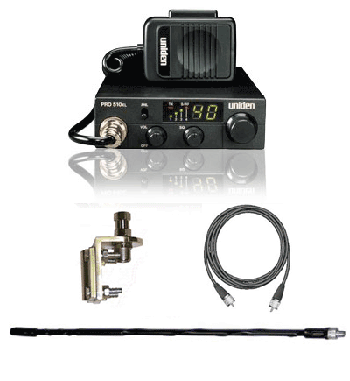 A CB radio is a useful tool for off-road driving. You can use it to communicate with all members of your party, listen in on general communication, monitor weather channels, operate a PA speaker and much more. However, CBs arenít like most plug-and-play items weíre used to purchasing. Installing a CB is relatively simple, but it can be tricky knowing how to fix an improper installation. This guide will help ensure a proper CB installation and allow you to troubleshoot common installation issues that might arise.
A CB radio is a useful tool for off-road driving. You can use it to communicate with all members of your party, listen in on general communication, monitor weather channels, operate a PA speaker and much more. However, CBs arenít like most plug-and-play items weíre used to purchasing. Installing a CB is relatively simple, but it can be tricky knowing how to fix an improper installation. This guide will help ensure a proper CB installation and allow you to troubleshoot common installation issues that might arise.
Components of a CB System
To have a functioning CB system, youíll need a CB radio, CB antenna, coax cable, mount and CB antenna stud. All of these items can be found at a good off-road shop or at our site, RightChannelRadios.com. Youíll also need an SWR meter in order to tune your antenna to match your vehicle and mounting location. When choosing a CB radio, consider the space available in your vehicle and how you intend to use your CB. Several CB radios have plenty of bells and whistles, many of which arenít important to off-roaders. When selecting a CB antenna and mounting location, we recommend that the tip of the antenna clear the roof of your vehicle by at least one foot. The longer the antenna you choose, the greater the range youíll achieve. To avoid any problems with range, youíll want the antenna to clear the roof of the vehicle.
Tuning and Testing Your CB System
Once youíve installed all components of your CB system, youíll need to test and tune your CB antenna. Testing your CB system will ensure top performance while identifying any installation issues. To do this, youíll need to use an SWR meter. Larger CB radios, such as the Cobra 29, have built-in SWR meters, but most compact CB radios, which are popular in off-road vehicles, do not. You can purchase a basic SWR meter and coax jumper cable for about $25.
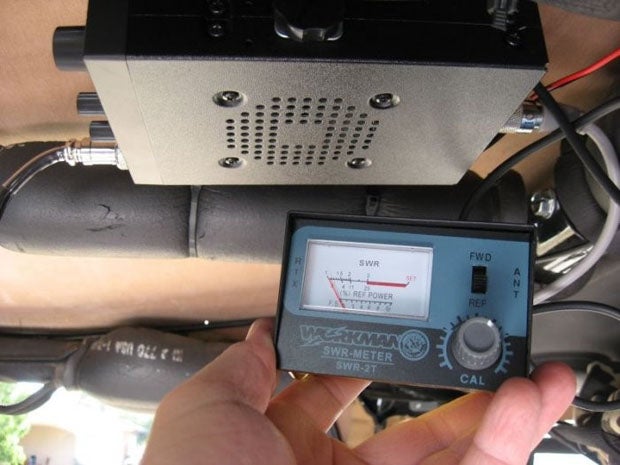
To use the SWR meter, attach the meter in line between the radio and the antenna using a short piece of coax called a jumper cable. To calibrate the SWR meter, switch the meter to the FWD function, key the CB microphone and use the calibration knob to move the needle to the ďsetĒ position. With the meter calibrated, key the microphone on the CB radio and move the switch from FWD to REF. Once you do this, the meter will display the systemís SWR. Test the SWR on channels 1 and 40, trying to achieve the lowest reading possible. To lower the reading, incrementally raise or lower the CB antenna by adjusting the tunable tip on top of the antenna. (Tunable tips are standard on most fiberglass CB antennas.) SWR readings between 1 and 2 are acceptable; readings between 2 and 2.9 indicate mounting problems or a poor antenna-to-vehicle match. If the SWR readings are 3 or higher, there is either a major installation problem or one of the CB components is defective or damaged.
 Troubleshooting High SWR
Troubleshooting High SWR
If your system SWR is measuring over 3, thereís likely a problem with your CB installation. To begin troubleshooting, we recommend that you first take a look at the CB setup to ensure everything is in place. Questions you should ask include:
Is the coax cable properly connected to the CB radio and the antenna stud?
Is any part of the coax cable crimped or damaged in any way?
Is the excess coax cable coiled too tight? (Excess coax cable should be stored in a lightly coiled figure eight pattern thatís 1.5 to 2í long and cinched in the middle.)
Is the nylon washer on the CB antenna stud in the correct place?
If you can answer yes to all of these questions, itís time to address a possible grounding issue.
Grounding Issues
Ninety-five percent of all CB problems are the result of poor grounding. CBís use the chassis of the vehicle to create a radio ground plane for transmitting and receiving CB signals, so itís critical that the CB mount is properly grounded. A great tool for identifying mounting areas that are properly grounded is the multimeter. Multimeters have the ability to measure resistance and therefore to identify areas where electrical signal can Ė and cannot Ė pass through. When using a multimeter for this purpose, be sure to set the meter to the ohm function, then simply touch one of the prongs to the antenna mount and the other to the body of the vehicle. When you do this, if the SWR meter displays a value of ď0Ē that indicates a closed circuit (no resistance) and a good grounding location. If the meter displays a numerical value, there is resistance between the mount and the potential mounting location. If this is the case, we recommend that you choose a different mounting location for best performance.
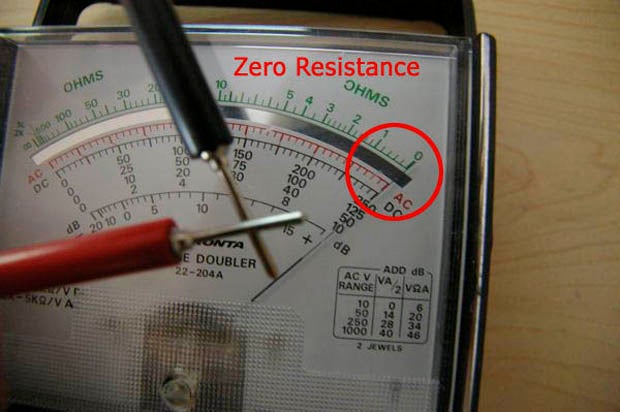
Identifying Defective or Damaged CB Parts
If you continue to have problems after youíve looked over your CB system and identified that the mount is properly grounded, itís time to test the individual parts of the CB system. Use the multimeter to test for continuity in the CB antenna and coax cable. This is accomplished by touching both ends of the multimeter probes to opposite ends of the CB antenna, to the opposite center pins of the CB coax, and to the outer shield of the CB coax. If any parts are faulty, youíll get a resistance reading on the multimeter. You can also test the coax cable by touching one prong to the male center pin and the other to the outer part of the screw-on connector. If the meter shows an open circuit, then the coax cable is damaged.
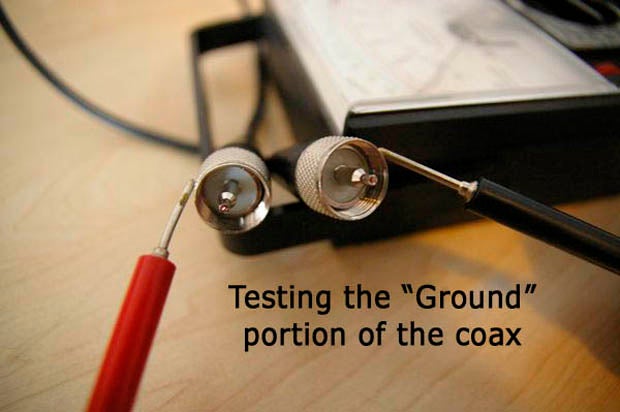
Common Installation Issues Specific to Off-Road Vehicles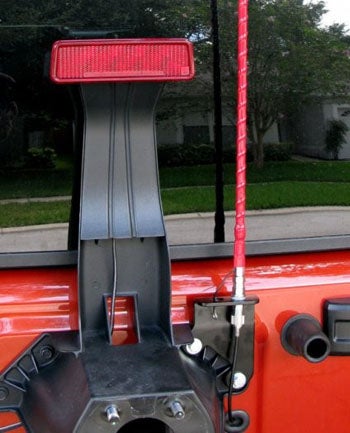 Due to the popularity of aftermarket bumpers, taillight covers, body armor and other accessories, many off-road vehicles are prone to grounding problems. This is usually because most of these off-road accessories are insulated with a powder coating. Ironically, many of these powder-coated accessories include holes for mounting a CB antenna. To create a proper ground, simply scrape off the powder coating where the bottom of the CB antenna stud comes in contact with the bumper or other accessory, and scrape off the coating where the accessory attaches to the vehicle. Then, use the multimeter to test the resistance between the mount and the chassis of the vehicle, which should show zero resistance.
Due to the popularity of aftermarket bumpers, taillight covers, body armor and other accessories, many off-road vehicles are prone to grounding problems. This is usually because most of these off-road accessories are insulated with a powder coating. Ironically, many of these powder-coated accessories include holes for mounting a CB antenna. To create a proper ground, simply scrape off the powder coating where the bottom of the CB antenna stud comes in contact with the bumper or other accessory, and scrape off the coating where the accessory attaches to the vehicle. Then, use the multimeter to test the resistance between the mount and the chassis of the vehicle, which should show zero resistance.
Another common pitfall is mounting a CB antenna to the tailgate of a Jeep or similar vehicle. Youíll likely experience grounding problems, because the mount will ground to the tailgate, but the tailgate is often not grounded to the body of the vehicle. This can cause high SWR readings when the mount appears to be grounded. To remedy this problem, simply run a grounding strap from the tailgate to the body of the Jeep, or run a grounding wire directly to the CB antenna stud.
Following the steps mentioned in this guide will help resolve 99 percent of all CB installation issues. Once your CB is properly installed, it will be a useful tool for off-road traveling and, hopefully, help you have more fun on your adventures!
About the Author
Right Channel CB Radios (http://www.rightchannelradios.com/) specializes in CB radios, CB Off-Road antennas (http://www.rightchannelradios.com/cb-antennas.html) and accessories for off-road drivers. They are dedicated to helping drivers select the best equipment for their vehicle and ensuring it works properly out on the trail.


 Your Privacy Choices
Your Privacy Choices